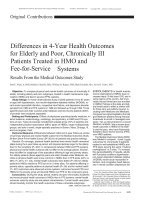True An Innovative Program For Elderly Inmates potx
Bạn đang xem bản rút gọn của tài liệu. Xem và tải ngay bản đầy đủ của tài liệu tại đây (250.25 KB, 4 trang )
46 — December 2006 Corrections Today
CT F
EATURE
True
An Innovative Program
For Elderly Inmates
By Mary T. Harrison
““
““
HH
HH
eeyy,, BBaatttteerr,, BBaatttteerr!! HHiitt tthhee bbaallll!!
WWhhaattssaammaatttteerr,, yyaa ccrriipppplleedd oorr bblliinndd??””
““
““
YY
YY
oouu oouugghhttaa kknnooww,, MMaacc,,
ppuusshheedd mmyy wwhheeeellcchhaaiirr bbeeffoo
ggeett oouuttttaa tthhee wwaayy!!””
Artwork and photos courtesy Nevada Department of Corrections
T
his banter was heard recently during a prison
wheelchair softball game at the Northern Nevada
Correctional Center (NNCC) in Carson City. Thirty
inmates, members of a structured living program
for elderly inmates, were engaging in one of the program's
most popular activities. The program, True Grit, is the
first of its kind in Nevada and attempts to deal with the
special needs of the rapidly increasing population of geri-
atric inmates.
A Proven Need
Nationally, the number of inmates in state and federal
correctional institutions increased approximately 750
percent from 1979 to 1997.
1
The reasons for this massive
increase include an aging “baby boomer” population
bulge, longer life expectancy, and lengthy mandatory sen-
tences and “life without” sentences for second-or third-
felony offenses.
2
The U.S. Census Bureau estimates that
the U.S. population will continue to age at the current rate
until 2010, and then the rate will accelerate. The U.S.
prison population is expected to mirror this trend.
In 2005, the Bureau of Justice Statistics found that 12
percent of male inmates incarcerated nationwide were
older than 50.
3
Based on data that indicate the average
inmate isphysiologically about 10 years older than a
cohort of never-incarcerated men, the Department of Jus-
tice has stated that age 50 is the appropriate benchmark
to indicate a “senior inmate.”
4
Reviews of data on inmate cost
indicate that the cost of incarcer-
ating a senior inmate is approxi-
mately three times that of a
younger man.
5
Several states, including
Florida,
6
Georgia,
7
Pennsylvania,
Oklahoma
8
and Maryland,
9
have
issued position papers or state-
ments concerning the increase in
elderly inmate populations and
their special needs. Prison
systems in Louisiana (at Angola Prison) and California (at
its Vacaville Medical Facility) have established model hos-
pice programs for terminally ill inmates, while other states
have experimented with compassionate early release pro-
grams. However, there has been little correctional pro-
gramming actually put in place for aging inmates who are
not terminally ill but are serving their “golden years”
behind bars.
A Winning Program
Recognizing the need to deal with this class of inmate,
Dorothy Nash Holmes, Nevada’s deputy director of correc-
tional programs, tasked NNCC’s staff psychologist with
developing a program to address the special physical, men-
tal, emotional and spiritual needs of elderly inmates. The
program was to be a structured living program as opposed
to a hospice, because the focus was to get the older inmates
out of their beds and into more activities and better health.
NNCC is essentially the state’s medical prison because it
encompasses the only inmate hospital (Regional Medical
Facility), houses a majority of Nevada’s mentally ill inmates
and houses most of the physically infirm inmates. Because
more than 300 of the facility’s 1,250 offenders are age 50 or
older and there was limited capacity for the program, the
difficult decision was made to set the minimum age for pro-
gram participation at 60.
It was a challenge, at first, to get the elderly inmates to
come to the meetings or participate in the planning
sessions because they were held in the Regional Medical
Facility. Once the staff psychologist realized that the
elderly inmates shied away from the medical facility
because “inmates go there to die,” the planning sessions
were moved into one of the housing units and inmates’
interest piqued. Inmates were allowed to apply, or were
referred by staff, and were then reviewed by a classified
committee to ensure eligibility. Assessment of each
potential candidate for the program included an evalua-
tion of criminal history, physical and mental health, work
history and skills, life skills, family ties, and community
relationships.
No state funds (other than the psychologist’s salary)
were expended to set up the program. NNCC Warden Don
Helling set aside a dayroom and office in one of the hous-
ing units for the program and they were renovated using
donated materials and inmate labor. Various service
organizations, charities and individuals donated materials
for hobby crafts and recreational activities. In April 2004,
an initial group of 50 men was accepted into the program.
Other special programs within the DOC had selected
catchy names and logos for themselves, and the “old
guys” didn’t want to be any different. After long, spirited
and sometimes heated debate, the name True Grit was
selected. Because one of the first special activities that
occurred was a visit by a large Flat-coat Retriever therapy
dog named Willie, it was a unanimous decision that the
dog should appear in the logo. A man in a wheelchair, and
an eye-patch for the dog completed the picture, and True
Grit was born. As a final touch, a local businessman donat-
ed T-shirts, sweatshirts and baseball caps with the
imprinted logo.
Together with Nevada’s Division of Aging Services, the
program was designed to enhance physical health
(by means of various recreational and physical therapy
activities); mental health (using group and individual ther-
apy and self-help modalities); and spiritual health (coordi-
nated with the prison chaplain and volunteers). It was
established as a daily program, with varying activities
each day of the week. Although all participants are not
required to engage in all activities, such involvement is
encouraged.
Contact with the local Delta Society brings two, and
sometimes three, large therapy dogs into the prison on a
December 2006 Corrections Today — 47
Grit
:
,, yyoouu’’vvee
oorree NNooww
””
monthly basis. During their first visit, there was not a dry
eye in the unit when an elderly inmate wept saying,
“I haven’t petted a dog in 37 years!” Willie, the “Death Row
Dog” (named that by the inmates because he was saved
from being euthanized), is often joined by a huge
Leonberger named Brendan and a golden retriever named
Baloo. These dogs provide stimulation and contact that
both the men and the dogs enjoy. One inmate, serving a life
sentence, has been “rejuvenated” by writing and perform-
ing songs about the therapy dogs. He says: “Before True
Grit, I spent 23 hours a day in my rack [bed]. Now I am in
the program, writing and performing songs.”
Warden Helling and Glen Whorton, the director of cor-
rections, both enthusiastically support the program. As the
program has matured and expanded, there have been
several additions. All materials used in the program have
been donated by various organizations or purchased using
funds from a handful of generous donors. Word of the pro-
gram spread in the community after the local newspaper
featured a front-page article with photos of the “old
codgers” playing a rough game of “wheelchair basketball.”
That exposure resulted in donations of supplies for crafts
and volunteers signing up to help.
Wheelchair softball during the warmer months and
wheelchair basketball during the winter provide needed
physical and social activity for the True Gritters. There was
resistance at first to using wheelchairs on the playing field
and basketball court, but once the activity got under way,
it was completely supported. In True Grit, these games are
not for the faint-hearted. In a recent, competitive wheel-
chair basketball game, there were a number of collisions
and one participant temporarily lost his artificial leg.
Despite that, Fred, 87, who is serving a life sentence,
declared, “I haven’t had this much fun in years.”
For the more fragile men who might suffer serious
injuries during vigorous sports, there is a pedometer pro-
gram, in which men walk (or roll their wheelchairs) around
a set course in the institution, racking up mileage and earn-
ing kudos. Their goal is 10,000 steps a day.
A prized activity by some of the men, and one that
keeps their arthritic fingers nimble, is making latch-hook
rugs. Helling granted special permission to get some of the
tools into the unit. Crafts that the men make are donated to
the local senior citizen’s center and sold through its craft
store, with the money going to the senior center. In this
way, the True Gritters can give back to the community.
One of the most spectacular successes of 2005 was the
True Grit production of “12 Angry Men.” The emotion and
realism that the inmates brought to this presentation was
amazing. The participants and the audience of regular
NNCC inmates thoroughly enjoyed the play. They have
proposed “The Producers” as their next featured play.
Each month, True Grit has a group birthday party for
members who have a sobriety birthday, a true birthday or
who are just celebrating surviving another year in prison.
The men of True Grit publish an occasional journal, which
comments on activities of the group over the previous
month, features inmate poetry, memorializes deceased
members and annotates upcoming events. One volunteer,
Ruth Stacy, started a project for the men to write “ethical
wills”— statements to their families as to how they would
like to be remembered after they die and, in some cases,
apologies to their victims.
True Grit includes a small cadre of “National Treasures”
— men in their 70s or 80s who fought in World War II. Later
in life they may have become habitual criminals after the
war or succumbed to violent behavior. Some have been
imprisoned because of vehicular homicide, while others
have been convicted of sexual offenses, possibly a result of
early Alzheimer’s disease or other cognitive impairment.
Regardless of their offense, their national service is
recognized and honored by the other inmates. For these
veteran True Gritters, the staff psychologist provides
donated books, journals and music about soldiers’ wartime
experiences.
Impact
What has been the impact of the True Grit Senior
Structured Living Program? Qualitatively (numerical data
are still being collected), the number of infirmary visits by
elderly inmates has decreased; the amount of psychotropic
and psychoactive medications they use has decreased; the
general feeling of well-being of the men in the program has
increased markedly; and the fear of dying alone in prison
has been reduced. On at least two occasions, men in the
program have died in prison, but they have died with one
or more of their peers with them. NNCC does not have a
formal prison hospice program in place, but the compan-
ionship of the men in True Grit provides a similar level of
support. The musical inmates in True Grit even serenade
their counterparts who are confined to the infirmary.
The elderly inmate situation is not going away, so
Nevada and the rest of the United States need to aggres-
sively address the issues of: advanced medical care in
prison, including hospices; geriatric mental health services;
transition and community re-integration for those who
John Henry Marks became a barber in
1947, after serving in World War II, and
cut hair for more than 50 years. Here he is
looking for his homerun of the day.
During a fall softball game, Jesse Roseen
(right), 87, tells Al Bailey (left), “This is the
most fun I’ve had in prison.” Bailey responds,
“This is the most fun I’ve had in my life.”
Stanley Brooks (right) performs an
original composition to Balou, a visitor
from the Delta Society.
48 — December 2006 Corrections Today
will be released; early (compassionate) release; and
post-incarceration housing.
True Grit is only a beginning, albeit a successful one.
What is next for Nevada’s elderly inmates? Program staff
plan to collect data in order to assess outcomes and pre-
sent such outcomes to the state Legislature. Additional
mental health assessments will be incorporated into the
program, and funding for additional programs via grants
from government and private sources is being pursued.
The perceived need for additional training of staff with
regard to the special needs of elderly inmates is being
addressed. An affiliation with a health sciences university
is being developed, with the idea that student interns in
various health-related disciplines will be able to learn while
working with the elderly inmates.
True Grit has provided the elderly inmates, many of
whom will be incarcerated for the rest of their lives, with a
reason to get up in the morning. They no longer spend
hours in bed or sit stagnant on the benches in the prison
yard. It has proved to be an effective way to assist the
neediest inmates and it parallels the kind of age-specific
activities and camaraderie they would get in a senior
citizen’s center in the community. As an added benefit,
seeing the “old guys” come back to life has given hope to
many other DOC inmates and has shown them some
humanity in a place that can, all too often, become devoid
of it.
ENDNOTES
1
Hoelter, H.J. 2001. Institutional issues. Journal of Rehabilitation
Research and Development, 38(1): S38-S39.
2
Georgia Department of Corrections. 2004. Executive Summary:
Georgia’s Aging Inmate Population. Augusta, Ga.: Georgia Depart-
ment of Corrections.
3
Bureau of Justice Statistics. 2005. BJS Bulletin. Washington, D.C.:
Department of Justice, Bureau of Justice Statistics. (January).
4
Falter, R.G. 1993. Selected predictors of health service needs of
imates over age 50. Doctoral. Dissertation, Walden University.
5
Department of Justice. 2000. Health issues and geriatric inmates.
Washington, D.C.: U.S. Department of Justice.
6
Florida House of Representatives. 1999. An examination of elder
inmates services: An aging crisis. Criminal Justice and Corrections
Council Committee on Corrections.
7
Georgia DOC, 2004.
8
Wheeler, M., M. Connelly and J. Wheeler. 1995. Aging of prison
populations: Directions for Oklahoma. Oklahoma Criminal Justice
Research Consortium, Vol. 2:72-79.
9
Duckett, N., T. Fox, T. Harsha and J. Vish. 2000. The aging prison
population. College Park, Md.: State Commission on Criminal
Sentencing Policy.
Mary T. Harrison, MS, is a psychologist II at the Northern
Nevada Correctional Center in Carson City.
December 2006 Corrections Today — 49









